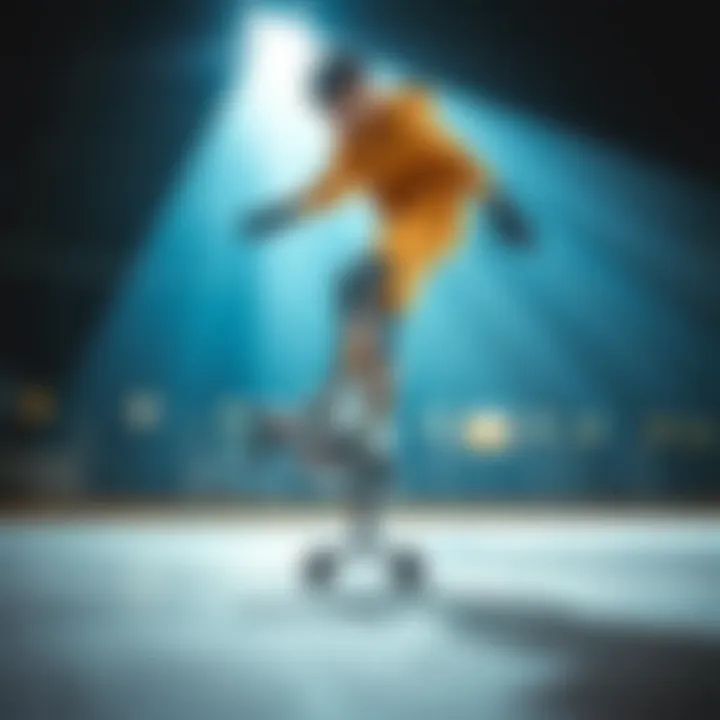Essential Guide for Beginner Skaters: Techniques & Tips


Intro
Skating is a captivating pursuit that not only brings joy but also offers a unique blend of physical activity and graceful movement. For those just stepping onto the scene, the journey can seem daunting, yet it is also filled with excitement and discovery. This guide is a treasure trove of essential knowledge meant for novices eager to embrace skating in all its forms.
The core of this adventure begins with understanding the equipment—finding the right skates can feel like searching for a needle in a haystack, but fret not! Every skate has its purpose, and knowing what fits your style and needs is key.
From the first glide on the surface to mastering advanced techniques, each phase builds upon the last. Safety considerations cannot be overstated; after all, prevention is always better than cure, right? Finally, continuous improvement will keep the passion alive as skills evolve.
So tighten those laces, and let’s dive into the fascinating world of skating, where wheels meet the pavement in a dance of rhythm and finesse.
Preface to Skating for Beginners
Skating is not merely a recreational activity; it serves as an escapade into a realm of agility, balance, and camaraderie. The journey into skating can be invigorating, yet it’s vital for beginners to grasp the fundamentals that will pave the way for an enjoyable experience. Grasping the essence of skating from the get-go is pivotal in developing not just the skills necessary to glide aesthetically across surfaces but also the confidence that every novice needs.
For many, skating represents the bridge between freedom and thrill. It provides an avenue to enjoy the outdoors while promoting fitness and coordination. Whether one is skimming on a smooth ice rink or rolling along a paved pathway, the core enjoyment stems from mastering the ability to control one’s motion and rhythm on skates. This guide aims to offer insight into the sport, illuminating key aspects that simplify the learning process for novices.
Understanding the Essence of Skating
At its heart, skating encapsulates the principles of movement and stability, blending art and sport in a fascinating manner. This multiplicity makes skating such a desirable activity for many enthusiasts. Skating isn't just about speed; it's also about expressing oneself through fluidity and grace. Each glide and turn speaks of the connection a skater establishes with their environment. From the slight tuck of elbows to the bending of knees, every posture matters.
Moreover, skating stimulates the mind and body simultaneously. It challenges coordination, enhances core strength, and cultivates spatial awareness. Beginners will soon notice increased endurance as they practice their balance and learn to navigate their skates. This physical engagement invigorates not only the joints but also sharpens cognitive abilities, making skating an all-around excellent choice for anyone wanting to break a sweat while having fun.
The Evolution of Skating
Skating has a rich history that dates back centuries. Initially originating in Northern Europe, this form of motion gained traction as a means of transport across frozen landscapes. It wasn't until the 18th century that skating transformed into the exhilarating sport we recognize today. This evolution showcases how societal shifts have influenced activities, turning utilitarian practices into recreational pastimes.
As modern skating evolved, various forms sprouted, each carving its niche. Ice skating branched into figure skating and speed skating, offering participants unique experiences, while roller skating spawned a lively social scene in roller rinks. This diversification reflects society's love for innovation and community, allowing various age groups to find their place. Skating today stands as a testament to human creativity and cultural expression.
"Skating merges physical exertion with artistic expression, making it one of the few sports where one can truly feel alive and free."
Understanding the significance behind each glide is a crucial stepping stone for any beginner venturing into this dynamic realm. The journey ahead is filled with potential, and as new skaters lace up, they’re not just putting on a pair of skates; they’re stepping into a tradition that blends community spirit and personal growth in every stride.
Types of Skating
Understanding the various types of skating is crucial for beginners. Choosing the right type not only influences your experience but also lays the foundation for your skills and preferences. Each skating style offers unique benefits, challenges, and environments. Knowing the differences can help you immerse yourself fully in this exhilarating world, whether you’re gliding on smooth ice or rolling down the street.
Roller Skating vs. Ice Skating
When it comes to skating, two primary forms stand out: roller skating and ice skating. Each has its own set of appeal and caters to different atmospheres.
Roller skating involves wheels mounted to a boot. It’s often done indoors on wooden or synthetic floors, or outdoors on concrete surfaces. Its advantages include the ability to practice year-round and a generally easier learning curve. Plus, there's no freezing cold to contend with! You can get started in your local park, often with minimal investment—just grab a pair of skates and you’re off.
Conversely, ice skating requires a rink with a surface of ice. This can be a bit daunting for beginners due to the inherent slipperiness and need for a more specialized skill set. However, once you get the hang of it, the experience transforms into a graceful glide that feels almost magical. Ice skaters can also enjoy wintertime outdoors activities, such as skating on frozen lakes, adding a layer of adventure to the mix.
Essentially, roller skating's main appeal lies in its accessibility and convenience, while ice skating offers a unique elegance and community, especially with seasonal events.
Street Skating
Street skating takes a more adventurous angle, where the whole urban environment becomes your playground. It’s not just about moving from point A to point B; it’s about exploring urban landscapes and finding new spots to skate—like curbs, stairs, and railings. This type of skating is often associated with a more expressive, creative style, where skaters can perform tricks and showcase their individuality. There’s a rawness to street skating that's captivating.
Moreover, it's become a cultural phenomenon, often shown in videos that highlight creativity. The only downside? It may come with a higher risk of injury compared to more controlled environments due to unpredictable terrains. However, the thrill of finding hidden gems in your city can be remarkably rewarding.
Ramp and Bowl Skating
Ramp and bowl skating represents the acrobatic side of the sport. Often found in skate parks, this style revolves around using transitions, such as quarter pipes, halfpipes, and bowls. The steep angles and curves allow skaters to gain impressive air and perform tricks that are simply extraordinary.
For beginners, learning on ramps can be intimidating, but progress will come with practice. Start with smaller ramps or mini bowls to build confidence. The sense of community among ramp skaters is comforting; fellow skaters often cheer on each other, fostering a supportive environment that encourages learning.
In sum, exploring different types of skating not only broadens your horizons but also enriches your skating journey. Whether you prefer the smooth glide of roller skating, the elegance of ice skating, the creativity of street skating, or the adrenaline of ramps, each style contributes to the rich tapestry of the skating community. Now that you've got an overview, it’s time to decide which style resonates with you and dive deeper into the world of skating.


Selecting the Right Equipment
Choosing the right equipment is crucial for anyone taking their first steps into the world of skating. Not only does the right gear enhance performance, but it also plays a significant role in ensuring safety and comfort. Imagine stepping out on wheels or blades without the right fit or safety gear – it’s a recipe for disaster. Not only could poor equipment lead to discomfort, but it could also increase the likelihood of injuries. Hence, understanding what to look for when selecting skates and safety gear can make all the difference in your skating experience.
Choosing the Right Skates
Choosing the right skates is like finding the perfect pair of shoes; it requires attention to detail and understanding of personal preferences.
Fit and Comfort
Fit and comfort are top priorities when selecting skates. If your skates don’t fit well, you’ll be in for a rough ride, both literally and figuratively. A snug fit helps in maintaining control and stability, while added comfort keeps you on your feet longer without feeling fatigued.
When it comes to fit, ensure that your skates hug your feet without being too tight. Ill-fitting skates can restrict blood flow, causing numbness and discomfort. It’s essential to try them on with the socks you intend to wear. Here’s a tip: your toes should just barely graze the front of the skate. If you can wiggle your toes easily, they might be too big.
Material Considerations
Material considerations are another essential piece of the puzzle. Skates come in various materials, including leather, synthetic fabrics, and plastic. Leather skates, though often pricier, typically provide better support and durability. On the flip side, synthetic options, while lighter and often cheaper, may not offer the same level of comfort and longevity. When selecting the material, think about your skating frequency and intended environment. For instance, if you plan to skate outdoors often, you might want a durable material that withstands elements – water and sun included.
Types of Wheels
Understanding types of wheels is crucial since they directly affect your skating experience. The diameter and hardness of wheels matter significantly. Larger wheels generally offer better speed and smoother rides, while smaller wheels provide quicker control but can lead to a rougher experience. There are soft and hard wheels as well. Softer wheels excel on rough surfaces, adding a level of grip, while harder wheels glide effortlessly on smooth surfaces. Depending on your style and terrain, opting for the correct type can transform your skating ability.
Essential Safety Gear
No matter how confident you feel on skates, safety gear is non-negotiable. It’s like wearing a seatbelt; you might never need it, but you'd be glad you had it when it matters most.
Helmets
A helmet is arguably the most crucial piece of safety gear for any skater. It protects your head from potential injuries in case of falls or accidents. A good helmet should fit snugly but not overly tight. It’s that piece of gear that sits on your head, offering the protection you need while allowing ventilation. Getting a lightweight design enhances comfort.
Wearing a helmet helps create a habit of safety, encouraging those young or new to skating to prioritize protection.
Knee and Elbow Pads
Knee and elbow pads are essential accessories that can prevent serious injuries in case of falls. The harsh reality is, whether you’re a beginner or seasoned skater, everyone takes a tumble from time to time. Pads cushion against impact and also add a layer of reassurance while learning. The comfort level of these pads can significantly affect your confidence to practice new techniques. It's vital to find pads that fit well and aren’t too bulky, allowing for movement while providing adequate protection.
Wrist Guards
Wrist guards are particularly important when you’re a beginner navigating the balancing act of skating. A common reaction during a fall is to catch yourself with your hands, which can lead to broken wrists or sprains. These guards offer protection while still allowing you the freedom to move. A good pair should conform to your wrists without being constricting. You can find options with adjustable straps for a more personalized fit.
"Safety doesn’t happen by accident. It’s a choice you make every time you skate."
Selecting the right equipment is a fundamental step for novice skaters. With the right skates, safety gear, and an understanding of how these elements work together, you'll be in a prime position to enjoy your skating journey. It’s all about starting smart and setting a solid foundation for your skills to flourish.
Basic Skating Techniques
Mastering basic skating techniques is a cornerstone for every beginner skater. These techniques not only lay the groundwork for more complex movements later on but also ensure that skaters feel confident and safe while they’re gliding on wheels or ice. Knowing how to balance properly, start, stop and maneuver can make a world of difference in mastering this exhilarating sport.
Balancing and Posture
The importance of balancing can’t be overstated. In skating, one must learn to trust their body’s ability to keep upright while in motion. Good posture enhances balance, which helps maintain control during turns or when facing obstacles. When a skater stands tall with their knees slightly bent, it places their center of gravity in a favorable position, allowing for better control. Skaters should focus on keeping their arms out, slightly bent, and use them for balance. This way, they remain agile and can react more swiftly to any sudden stops or shifts in direction.
Practicing balancing exercises, like standing on one leg while rolling slowly, can significantly improve a skater’s comfort level on their skates. The real trick is to remember: the softer your knees, the more stable you will be.
Starting and Stopping
Starting and stopping are crucial in skating as they dictate the flow and safety of the activity.
Push-Off Technique
The push-off technique is foundational when beginning to skate. This involves propelling oneself forward by pushing off with one foot while the other remains planted. The key characteristic of this method is its simplicity; it’s intuitive and can be practiced easily in a safe environment.
What makes the push-off technique popular is that it promotes leg strength and coordination. Skaters should take their time mastering it, as rushing can lead to falls. It’s beneficial because it enables a skater to build speed gradually rather than abruptly, which can be unsafe for newcomers. However, the unique aspect of the push-off is that it requires practice to get the motion fluid; some may initially find it awkward or challenging.


Breaking Methods
Stopping effectively is just as important as starting. This is where breaking methods come into play. The most common stopping techniques include the snowplow stop and the T-stop. The snowplow stop involves pushing the heels outward while bending the knees to decrease speed. An advantage of this method is that it allows for controlled stopping while still maintaining balance. However, it can be less effective on smoother surfaces and requires skaters to have some momentum to be useful. More advanced beginners might prefer the T-stop; this involves dragging one skate perpendicularly behind the other. It's efficient and can help bring a skater to a stop quickly, thus offering multiple benefits in various skating environments.
Turning and Maneuvering
Turning and maneuvering add flair and skill to skating. These techniques provide skaters with the ability to navigate through obstacles and change direction efficiently.
Basic Turns
Basic turns are essential for beginners. These involve shifting weight from one skate to another and leaning into the turn. The significance of mastering basic turns lies in avoiding collisions and remaining in control of movement. They are a preferred choice because they encourage skaters to readjust their body dynamics, enhancing overall agility and making maneuvers easier. However, beginners may find them uncomfortable at first. The unique aspect of basic turns is learning to feel the weight shift, as it helps dictate the sharpness of the turn.
Advanced Maneuvers
As skaters gain confidence, exploring advanced maneuvers can be quite rewarding. This might include techniques such as cross-overs or spins. The beauty of these maneuvers is that they allow for a higher level of expression and creativity on skates. They contribute by improving speed and disrupting the monotony of straightforward skating. Skaters who learn them often consider it a rite of passage; however, they require a solid foundation in basic techniques. The unique feature of advanced maneuvers is their complexity, which can lead to frustration for some beginners.
Embracing the basics will streamline the journey into these advanced techniques, ensuring skaters have both the skill and confidence needed to flourish in their skating endeavors.
Safety Practices for Beginners
Skating, while thrilling, demands an approach rooted in safety to ensure a positive experience for newcomers. Understanding the importance of safety practices not only helps in preventing injuries but also contributes to building confidence on wheels or blades. Whether you're gliding on ice or rolling on pavement, mastering the basics of safety can make a world of difference in your skating journey.
Understanding Your Environment
Your surroundings can transform your skating experience. Whenever you step onto a rink or a street, being aware of the environment is vital. Factors like the surface condition, traffic patterns, and the presence of other skaters all influence safety.
- Surface Condition: A well-maintained surface ensures smoother rides. Uneven asphalt or cracks can lead to accidents. Before skating, take a moment to inspect the area.
- Weather Considerations: If you're skating outdoors, the weather is a player in the game too. Wet or icy surfaces can pose risks. It’s best to steer clear of wet pavement or sheets of ice!
- Traffic Patterns: In urban settings, always be alert for motor vehicles. Understand how cars behave on roads, and don’t forget about pedestrians and cyclists. Knowing where to skate can keep you safe.
Avoiding Common Injuries
Recognizing Risk Factors
In the realm of skating, understanding the risk factors associated with injuries is foundational.
- Key Characteristics: New skaters often underestimate their inexperience. The eagerness to learn can overshadow the need for caution. Recognizing that falls and collisions are likely in the learning phase is crucial.
- Unique Feature: Awareness of your personal limits is invaluable. Knowing when you might push too far, whether in speed or complexity, helps in avoiding nasty spills.
The benefits of recognizing these risk factors are significant. It allows skaters to enter the rink or the street mentally prepared, reducing anxiety and reinforcing the importance of protective equipment.
Preventative Strategies
This aspect emphasizes the proactive measures skaters can adopt to ensure safety while enjoying the sport.
- Key Characteristics: Regular warm-ups can help prepare the body for the physical demands of skating. Simple stretches can improve flexibility and reduce muscle strains.
- Unique Feature: Being aware of the need for proper gear, such as helmets, pads, or even wrist supports, enhances safety. These items absorb impact and prevent injuries in case of falls.
Incorporating these preventative strategies has tremendous advantages. Not only do they mitigate risks, but they also improve overall confidence levels. Understanding that you’re protected allows skaters to focus on enjoyment rather than fear.
Progressing in Skating Skills
As a beginner, the thrill of skating becomes even more exhilarating when you start to see growth in your skills. Progressing in skating is not just about mastering the basic moves; it extends far into developing confidence and enjoying the nuances of the sport. In this section, we will explore how the concept of skill progression plays a significant role in shaping your journey as a skater.
Setting realistic benchmarks helps keep your motivation high. The learning curve may be steep, but with each small win, you’ll find yourself gaining momentum, which breeds further improvement. Skating opens up a world of possibilities. Whether you're gliding across a rink or zig-zagging down a street, nailing those little tricks elevates the entire experience.
Each progressive step, from learning to balance properly to executing tricks, adds layers to your skating capabilities. Plus, as you move along this path, you’ll likely find yourself immersed in the skating culture, joining groups and, perhaps even participating in local events, contributing to a sense of belonging within the community. In short, building on your skills not only makes you a better skater but also enriches your experience.
Setting Achievable Goals
When navigating the learning curve in skating, creating achievable goals is crucial. Without direction, you might feel like you're chasing your tail and getting nowhere fast. Think of short-term objectives that gradually lead to long-term aspirations. For instance, start by focusing on perfecting your balance, then work toward pushing off or stopping more efficiently. These small milestones can make a significant impact on your overall progress.


Tips for Setting Your Goals
- Specific: Outline what you want to achieve — for example, "I want to learn how to stop using the T-stop method within a month."
- Measurable: Use metrics to gauge your progress. Keeping track of the number of successful attempts can be motivating.
- Attainable: Be realistic. It’s important not to set the bar too high initially.
By focusing on these aspects, you can create a structured pathway that encourages growth without overwhelming you.
Resources for Improvement
Once you have set your goals, the next step is to find resources that foster your improvement. Today, several options exist catering to different learning styles.
Online Tutorials
In the digital age, online tutorials represent an invaluable resource for aspiring skaters. These resources come in various forms, like videos, articles, and forums that help beginners refine their techniques. One remarkable characteristic of online tutorials is their accessibility. You can learn at your own pace, revisiting concepts whenever needed, which is great for those who prefer a self-directed learning environment.
Advantages of Online Tutorials:
- Flexibility: You control your learning schedule.
- Wide range: Tutorials often cover a vast array of topics, from basic techniques to advanced tricks.
- Community engagement: Many platforms offer discussion forums where skaters can ask questions and share experiences.
However, one must be cautious about the quality of the content as some tutorials may not provide the right guidance. Ensure the source is reputable, perhaps checking platforms like YouTube, or sites like reddit.com/r/skating for recommendations from seasoned skaters.
Local Classes
Local classes offer a practical alternative to online learning and bring the bonus of real-time feedback. Having an instructor who is knowledgeable can make a world of difference, as they can spot mistakes and provide immediate correction. This hands-on approach allows for a tailored learning experience that online resources sometimes lack.
Benefits of Local Classes:
- Direct instruction: Personal tips from experienced skaters may help refine your technique much faster.
- Interaction: Engaging with fellow beginners allows for mutual support and camaraderie, crucial for maintaining motivation.
- Structured learning: Classes often follow a curriculum designed to enhance skill progressively.
Nevertheless, local classes may have scheduled times that can clash with personal commitments and might require payment, but it's often considered an investment in your skill set and confidence.
By leveraging both online tutorials and local classes, you create a balanced approach that caters to various learning styles. Feel free to explore combining these resources to find what suits you best as you journey toward becoming a better skater. The road ahead may be long, but with every push on your skates, you’re one step closer to reaching your goals.
Community and Culture of Skating
Skating isn’t just about gliding on wheels or ice; it's a culture that weaves connections among people from all walks of life. From the moment you lace up your skates, you're stepping into a community built on shared passions, where camaraderie thrives and experiences are exchanged. This section delves into the vibrant tapestry of skating culture, shedding light on the importance of community, the value found in local groups, and the magnetic pull of events and competitions.
Finding Local Skating Groups
Finding a local skating group can make all the difference in your skating journey. It’s not only about learning techniques; it's about connecting with others who share the same excitement. Imagine meeting a friend who teaches you a trick while providing encouragement at the same time. Places to look for these groups include community centers, skate parks, and social media platforms.
- Community Centers and Skate Parks: These venues often host skating sessions where enthusiasts meet regularly. Check bulletin boards for flyers and announcements.
- Online Platforms: Websites like reddit.com contain dedicated skating communities where members arrange meet-ups. Social media groups on Facebook can also lead you to local skating events or communities that suit your interests.
- Word of Mouth: Don't underestimate the power of conversation. Chat with fellow skaters about any groups or clubs they might know. Fellow enthusiasts can often give valuable leads that you might not find online.
Joining a local skating group creates an environment where you can learn, grow, and even compete if you so desire. The support system is vital—after all, it's often easier to progress when someone else is cheering you on.
The Role of Events and Competitions
Events and competitions act as a cornerstone of the skating culture. They not only provide a stage for showcasing talents but also create opportunities for socializing and learning. From local skate-offs to larger tournaments, these gatherings are reflections of the community's spirit.
- Skill Development: Participating in events often pushes skaters to hone their skills. Preparation for a competition requires practicing maneuvers that may not be part of your usual routine. This practice can lead to significant improvement.
- Networking: Events bring together skaters from various backgrounds. It’s a chance to meet seasoned pros, discuss techniques, and even forge lifelong friendships. Networking in this way can open doors for mentorship or collaboration.
- Celebration of Talent: Competitions serve as celebration venues for the sport. Here, you stand among fellow skaters; the atmosphere is often electric, buzzing with anticipation and excitement, a reminder of why you fell in love with skating in the first place.
Remember, it’s not always about winning. Participation alone can be fulfilling and inspiring, pushing you to perfect your craft while becoming part of something greater.
Epilogue
Reflecting on the journey of learning skating, one can appreciate that it is more than just a physical activity; it's an avenue for self-expression and a way to foster confidence. This guide has delved into various elements that are crucial for beginners, emphasizing safe practices, the right equipment, and skill progression. Each topic has been tailored to build a solid foundation, empowering you as a skater.
Recap of Key Points
- Understanding Components of Skating:
Skating is multifaceted—comprising not only the act of gliding but also the technique, safety practices, and community support. Each element interlocks to create a holistic skating experience. - Safety is Paramount:
Wearing appropriate safety gear can mean the difference between a fun ride and a painful fall. From helmets to pads, taking precautions proves to be essential for an enjoyable experience. - Skill Development:
Building skills in skating doesn’t happen overnight. It requires patience, persistence, and setting realistic goals that allow you to track your progress. - Community Engagement:
Getting involved with local skating groups or events opens doors to learning experiences and friendships. The skate culture thrives on sharing tricks, tips, and laughter, making your journey less solitary and more enriching.
Encouragement for Continuation
Skating is a path of continual growth. Remember, every expert was once a beginner, and every bruise is a badge of honor in this exhilarating sport. Set aside some time each week to practice; even small increments lead to significant improvements. Dive deeper into resources like online tutorials or local classes when you're ready.
Consider how exhilarating it feels to skate with ease and confidence. Each moment spent on wheels is an opportunity. So, keep the momentum going, seek out challenges, and connect with fellow skaters. As you skate forward, embrace the freedom and joy that this activity brings. Because at the end of the day, it’s not just about reaching the destination—it’s about enjoying the ride.



